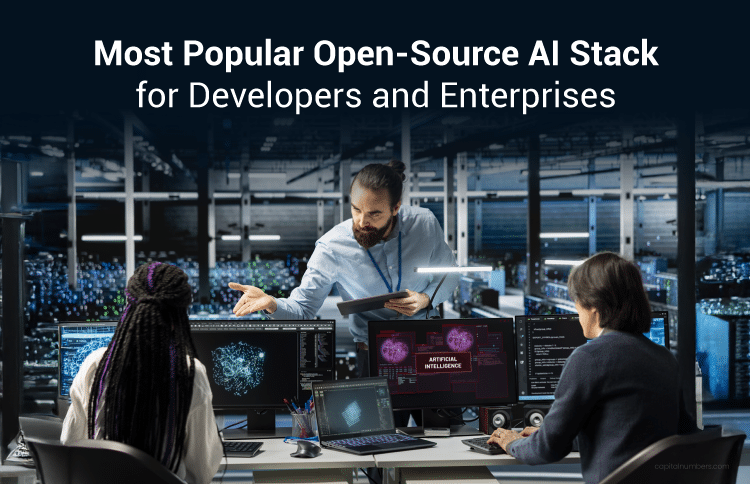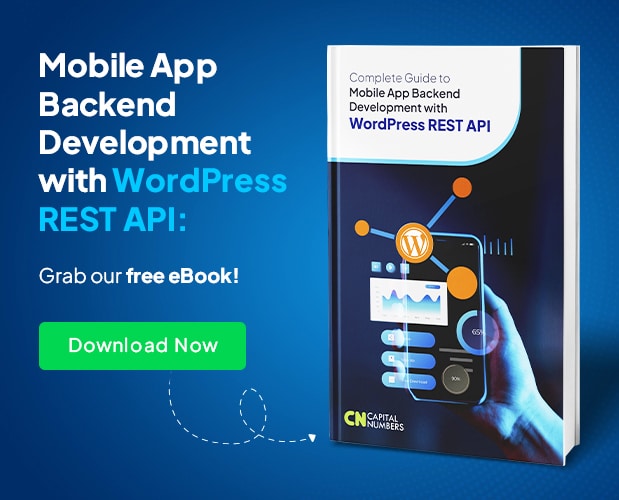Open-Source AI Stack: Best Tools for Devs and Enterprises
Table of Contents
Are high licensing fees and rigid limitations of proprietary AI tools holding your enterprise back? You’re not alone. More businesses are realizing that expensive, closed-box AI tools just don’t cut it anymore. The open-source movement is here to change the game.
Open-source AI stacks offer a cost-effective, flexible, and scalable solution, empowering businesses to innovate without the steep price tag. Plus, with a thriving community behind these stacks, you’ll always stay ahead, accessing the latest advancements and cutting-edge solutions.
In this blog, we’ll explain what open-source AI stacks are, followed by a look at the best tools for enterprises and developers, covering everything from frameworks to deployment. Whether you’re building models, deploying solutions, or managing data, these stacks will help you create smarter, faster, and more affordable AI systems. So, what are you waiting for? Let’s dive in!
What Is an Open-Source AI Stack?
An open-source AI stack is a collection of free, publicly available tools and frameworks used to build, train, deploy, and manage AI applications. It typically includes components for data processing, machine learning, model training, deployment, and monitoring. These tools work together to create a complete pipeline – from raw data to intelligent output. Because they’re open-source, teams can customize them, avoid licensing fees, and benefit from continuous improvements driven by global developer communities.
The Key Categories of the Open-Source AI Stack
The open-source AI ecosystem is vast, with a wide range of tools available across various categories. Each of these tools plays a crucial role in the development and deployment of AI applications. From deep learning frameworks to data management platforms, these AI helpers for developers ensure powerful solutions that cater to diverse business needs. Here’s a breakdown of the key categories within the most popular open-source AI stack for developers and enterprises:
1. Open-source AI Frameworks and Libraries
Frameworks and libraries are the backbone of the open-source AI stack, giving developers the tools to build smarter systems faster. They support deep learning, reinforcement learning, and traditional machine learning, offering flexibility and scalability. These open-source AI frameworks and libraries make it easier to test ideas, deploy models, and benefit from a strong, community-driven ecosystem.
Deep Learning Frameworks
- TensorFlow: Developed by Google, TensorFlow is a highly flexible and scalable open-source AI framework for deep learning models. It offers deployment capabilities with TensorFlow Serving for serving models in production, and TensorFlow Lite for efficient model deployment on mobile and embedded devices.
- PyTorch: Famous for its dynamic computation graphs, PyTorch is ideal for research and rapid prototyping. It also supports production deployment via TorchServe for scalable model serving and offers integration with C++ for high-performance environments. Its flexibility makes it an excellent choice for both experimental research and production-grade AI systems.
- JAX: A high-performance library for numerical computing, JAX extends NumPy with automatic differentiation and GPU/TPU support. It’s great for deep learning and research tasks that require fast optimization and high performance.
- Keras: A high-level neural network API built on TensorFlow, Keras simplifies model creation and experimentation. Keras makes it easier to design and train complex architectures quickly.
Reinforcement Learning Libraries
- OpenAI Gym: A versatile toolkit for building and testing reinforcement learning algorithms. This open-source AI library offers a wide variety of environments to simulate real-world scenarios and benchmark RL models.
- RLlib: Built on Ray, RLlib is designed for scalable reinforcement learning. It enables developers to train and deploy large RL systems efficiently.
Other Open-source Libraries
- Scikit-learn: A simple yet powerful machine learning library built on NumPy and SciPy, Scikit-learn provides tools for classification, regression, clustering, and preprocessing. Best suited for small to medium-scale machine learning problems, Scikit-learn may not be optimal for extremely large datasets, where frameworks like TensorFlow or PyTorch are better suited for scalability.
- XGBoost: A high-performance gradient boosting library, XGBoost is known for its speed, scalability, and accuracy. It’s widely used in competitions and enterprise applications for predictive modeling.
These best open-source AI frameworks offer developers the flexibility, efficiency, and community-driven innovation necessary to build high-performing, enterprise-grade AI solutions.
Ready to integrate AI into your business?
At Capital Numbers, we specialize in we AI development services using the open-source AI stack, helping you create smarter solutions that drive growth. Let’s talk about how we can transform your business with AI. Reach out for a quick consultation.
2. Open-source Frontend Tools for AI Applications
A great AI model needs a great interface. These open-source AI tools simplify frontend development, making it easier and faster to build interactive, AI-powered user interfaces.
- Streamlit: A powerful open-source framework designed to help developers quickly create interactive machine learning interfaces. With Streamlit, you can easily visualize data, display model outputs, and build interactive dashboards with minimal code. It integrates seamlessly with popular machine learning libraries like TensorFlow, PyTorch, and Scikit-learn, making it an ideal choice for turning machine learning models into real-time user interfaces. Streamlit’s simple and intuitive syntax enables even those with limited frontend experience to create user-friendly interfaces, allowing teams to share insights and results interactively with stakeholders and end-users.
These open-source AI tools for frontend development simplify the process, enabling developers to focus on creating smart, user-friendly AI interfaces without worrying about setup or deployment.
3. Open-source Embeddings and Retrieval-Augmented Generation (RAG) Tools
When it comes to AI-powered search, having the right tools to retrieve accurate information is essential. With the open-source AI stack, businesses can use a variety of tools for retrieval-augmented generation (RAG), a technique that combines data retrieval with generative models to enhance search accuracy and improve data retrieval efficiency.
- Nomic: A tool designed for managing and deploying retrieval-augmented generation (RAG) models. It boosts search accuracy by understanding the context and returning more relevant results. Nomic simplifies integrating AI-driven search into applications, making it easier for businesses to improve their search functions.
- JinaAI: A platform that simplifies the creation of neural search applications, enhancing search functionality with AI. It allows developers to build fast, scalable, and highly efficient search engines. JinaAI leverages deep learning models to improve search relevance and speed in large datasets.
- LlamaIndex: A flexible framework designed to integrate large language models with data sources, allowing businesses to build RAG systems that improve search and data retrieval accuracy. It offers a simple interface for efficiently querying data sources using AI models.
- Haystack: An end-to-end framework that simplifies the process of building production-ready search systems powered by transformers and neural networks, improving search results by leveraging RAG. It supports advanced features like question answering and document retrieval for enhanced search functionality.
- Chroma: An open-source vector store designed for storing and managing embeddings, enabling businesses to efficiently store, search, and retrieve high-dimensional data for RAG applications. Chroma helps scale AI search systems with its fast and flexible vector search capabilities.
These best open-source AI tools help businesses build smarter AI systems by improving search accuracy and data retrieval, ensuring efficient, context-aware search functionality.
How We Built a Teleradiology App for Smarter Patient Care
The client wanted to build a teleradiology app that can integrate data from X-ray, MRI, Mammography, CT Scan, and Ultrasound machines into the app’s dashboard for analysis. They needed AI to process images fast and generate reports in real-time, without any delays.
Learn how we developed the app by integrating data through Python scripts, using Orthanc for analysis, MySQL for storage, and a Node.js backend with a React frontend, all powered by AI algorithms for fast, secure, and accurate report generation. [Read the full case study here]
4. Open-source Backend and Model Access Tools
Building scalable AI applications requires efficient backend systems and easy model integration. The open-source AI stack provides a range of AI frameworks that make it easier for developers to deploy and manage AI models seamlessly.
- FastAPI: It is a high-performance Python framework for building APIs, perfect for deploying AI models quickly. FastAPI provides automatic validation, asynchronous support, and fast response times. However, for optimal concurrency, it’s important to use an ASGI server (e.g., Uvicorn or Gunicorn with workers) and implement ideal patterns for model inference, such as asynchronous processing, background workers, and batching requests for efficient GPU scheduling.
- Langchain: It is a framework designed to integrate language models into applications, thereby simplifying NLP tasks. Langchain helps developers manage prompts, chain multiple models, and build AI-powered workflows efficiently, making it one of the best open-source AI frameworks for enterprises. However, it is not a standalone serving system and must be paired with a server or model host (e.g., Hugging Face, Ollama, or local runtimes) for serving models.
- Netflix Metaflow: It is a human-centric data science framework for managing machine learning workflows. Metaflow streamlines model versioning, orchestration, and scaling, allowing teams to focus on innovation rather than infrastructure.
- Ollama: It is a platform for managing and deploying local LLMs, designed with ease of use and scalability in mind. Ollama helps businesses deploy language models locally and efficiently without the need for a dedicated cloud-based service. It’s important to note that Ollama is a product for model deployment, not a model itself.
- Hugging Face: Hugging Face is a widely used platform for accessing and deploying open-source large language models. It provides a rich model hub, APIs, and integrations, allowing developers and enterprises to quickly leverage cutting-edge NLP capabilities.
These open-source AI tools empower developers to build, deploy, and scale AI solutions efficiently, reducing complexity while maximizing performance.
You May Also Read: How to Hire the Best AI Developer (Without Overpaying or Wasting Time)
5. Open-source Data Storage and Retrieval Tools for AI Applications
Managing and retrieving data efficiently is crucial for AI applications, especially when dealing with large datasets. This open-source AI stack offers various tools to handle this, ensuring fast and scalable AI solutions.
- PostgreSQL: A robust relational database commonly used for storing data in AI projects. Known for its reliability and scalability, PostgreSQL is ideal for managing large amounts of data and integrates well with AI frameworks to support seamless AI model deployments.
- PGVector: An extension for PostgreSQL that adds support for vector data types, enabling efficient similarity searches within the database.
- Minimum PostgreSQL version: 12.0 or higher.
- Performance considerations: For optimal performance, consider the type of indexing used:
- ivfflat: Best suited for lower-dimensional data, offering faster search times.
- HNSW (Hierarchical Navigable Small World): More accurate for high-dimensional data, but with slower search speeds. The choice of indexing method will depend on the specific use case and the trade-offs between speed and accuracy.
- PGVector: An extension for PostgreSQL that adds support for vector data types, enabling efficient similarity searches within the database.
- Milvus: It is a vector database that is built specifically for similarity search. Milvus helps AI systems quickly find and retrieve similar data points, which is essential for AI-powered search engines. It is designed to handle high-speed search across large datasets, improving search accuracy and performance. Milvus focuses on high-throughput vector similarity search and is particularly well-suited for large-scale data retrieval.
- Weaviate: It is a semantic search engine that uses machine learning to understand the context of data. Weaviate goes beyond traditional keyword-based search by enabling AI systems to retrieve context-rich data, improving search relevance and user experience in AI applications.
- Weaviate vs. Milvus: Weaviate offers semantic search features, plugin modules, and built-in vectorization endpoints, making it more versatile for integrating machine learning and AI into search systems. In contrast, Milvus focuses on high-throughput vector similarity search, delivering superior performance for large-scale, high-speed data retrieval tasks. Depending on the needs of your project, Weaviate is ideal for applications requiring semantic understanding, while Milvus is better suited for raw performance in vector similarity search.
- FAISS: A library developed by Facebook for fast similarity searches. FAISS is optimized for AI applications that need to find relevant data quickly, such as nearest neighbor searches. However, it’s important to note that FAISS is an Approximate Nearest Neighbor (ANN) library. This means that it requires you to manage the persistence of vectors (storing the data) or use a database wrapper to manage persistence across sessions. While it offers high performance in large-scale vector search, additional infrastructure is needed to handle storage and data management.
These open-source AI tools and platforms simplify the process of managing and retrieving data, making AI systems more efficient and scalable.
6. Open-source Large Language Models (LLMs)
Large Language Models (LLMs) are transforming how we interact with AI, powering everything from chatbots to complex language-based tasks. The open-source AI stack offers a range of powerful, open-source large language models that help businesses build smarter and more efficient NLP applications.
- Meta’s Llama: Meta’s open-source alternative to proprietary LLMs, Llama is designed to offer advanced NLP capabilities while being flexible and efficient. It’s a great option for businesses looking to integrate language models without the high costs of proprietary tools.
- Mistral: Built for high performance in NLP tasks, Mistral is fast and efficient, making it perfect for applications that require quick language processing. Its lightweight design ensures fast training and deployment, helping businesses save time and resources.
- Qwen: Focused on pushing the limits of language processing, Qwen offers powerful features for various NLP applications. Whether it’s for improving customer interactions or automating content, Qwen makes it easy to integrate language capabilities into your AI projects.
- Phi: Known for its strength and versatility, Phi handles a wide range of NLP tasks like sentiment analysis and text summarization with ease. It’s a great tool for businesses needing a reliable, general-purpose language model.
- Gemma: A flexible, open-source LLM, Gemma is designed to boost performance across different NLP tasks. It adapts well to various data sets, making it a solid choice for businesses building scalable language applications.
These open-source tools help businesses enhance their AI systems, offering smart, flexible, and cost-effective solutions for working with language.
7. Open-source MLOps and Model Deployment Tools
Deploying and managing AI models smoothly is key to scaling AI solutions. The open-source AI stack offers a range of AI tools that make the entire process faster and more efficient, helping businesses streamline their workflows and get AI models up and running quickly.
- Kubeflow: A platform built for scalable machine learning workflows on Kubernetes. Kubeflow helps businesses easily deploy, manage, and scale AI models in the cloud, making MLOps easier and more efficient.
- MLflow: A tool for managing the machine learning lifecycle, from tracking experiments to deploying models. MLflow makes it simple to monitor and manage models throughout their entire journey, helping teams stay organized and focused.
- Ray: A distributed computing framework that speeds up AI workflows and scales easily. Ray helps businesses handle large datasets and complex computations, making it easier to build and deploy AI models at scale.
- Seldon Core: A Kubernetes-native platform for deploying, monitoring, and managing machine learning models in production. It helps businesses scale model deployments efficiently while ensuring performance and reliability.
- KServe: A Kubernetes-native tool designed for serving machine learning models. KServe simplifies the deployment and management of models, offering high scalability and performance for production environments.
- Kedro: An open-source framework for orchestrating machine learning pipelines, Kedro helps businesses manage and scale their data science workflows while ensuring reproducibility and modularity in AI projects.
- Weights & Biases (W&B): Although not fully open-source, W&B is widely used for tracking experiments, visualizing results, and managing datasets, making it an essential tool in MLOps.
- Kubernetes-native Serving Alternatives (Seldon/KServe): These tools provide flexible, scalable solutions for serving AI models directly on Kubernetes, enabling seamless integration and deployment in production.
These open-source AI tools simplify the deployment and management of AI models, enabling businesses to scale their AI projects smoothly.
Licensing, Data Provenance, and Model Governance for AI Applications
When adopting open-source AI tools, data provenance and model governance are critical to ensuring the reliability, transparency, and ethical use of AI models. This is especially important in regulated industries like healthcare, finance, and legal sectors, where data privacy laws must be followed.
- Data Provenance: Ensuring the traceability of the data used for training AI models is crucial. Enterprises need to track where their data originates, how it is processed, and how it flows through the AI model lifecycle. This is particularly vital when using open-source models like Meta’s Llama, Mistral, or Phi, where the training datasets may come from multiple, often unclear, sources. Managing data lineage helps ensure compliance with data privacy regulations such as GDPR (General Data Protection Regulation) in the EU or HIPAA (Health Insurance Portability and Accountability Act) in the U.S. for healthcare data.
- Model Governance: Enterprises must establish a framework for monitoring and controlling AI models, ensuring they perform as expected and adhere to ethical guidelines. This involves maintaining a model card (documenting the model’s intended use, limitations, and performance), tracking model versions, and implementing access control to restrict unauthorized modifications or deployments.
- Licensing: Different open-source AI models come with various licenses that specify how they can be used, shared, and modified. It’s essential to understand the acceptable use policies associated with these models to ensure that they align with the business’s goals and legal requirements. For example, Llama, Mistral, and Gemma have different licensing terms that may impose restrictions on commercial use, redistribution, or modification. Always verify the licensing terms to avoid potential legal issues down the line.
Enterprise Recommendation:
Adopt a Machine Learning Governance Checklist to ensure that AI models are managed throughout their lifecycle. This checklist should include:
- Model Cards: Provide detailed documentation of each model’s functionality, limitations, and ethical considerations.
- Data Lineage: Track and document the flow and transformation of data used to train and test models.
- Access Control: Restrict access to models and data to authorized personnel only.
- Audit Logs: Maintain detailed logs of model interactions and updates to ensure transparency and accountability.
By managing licensing, data provenance, and model governance, enterprises can confidently deploy open-source AI tools while adhering to regulatory standards and ethical guidelines.
Things to Consider When Choosing an AI Tech Stack
Picking the right open-source AI stack is crucial to building powerful AI solutions that actually work for your business. To make sure you’re set up for success, here are some key factors to consider when choosing these AI tools:
Project Requirements:
First, figure out what your AI project needs – whether it’s deep learning, machine learning, or NLP. This helps you pick the right AI frameworks and tools. For deep learning, go with TensorFlow or PyTorch, and for NLP, check out Hugging Face’s open-source large language models.
Scalability and Performance:
Can your tools handle large-scale data and complex computations? If you’re tackling high-performance tasks, tools like TensorFlow and PyTorch offer the power and scalability you need.
Community Support:
A strong, active community can make all the difference. Look for frameworks like Hugging Face or PyTorch, where you can access tons of resources, troubleshoot problems, and get regular updates from a vibrant, collaborative community.
Integration with Existing Systems:
Don’t pick a tech stack that’s going to cause headaches with your current systems. Make sure the open-source AI platforms you choose can integrate smoothly with your existing software and infrastructure.
Ease of Use and Documentation:
Some tools are more beginner-friendly than others. If you need to prototype quickly, tools like Streamlit and Keras offer easy-to-follow documentation and a simple learning curve.
Security and Compliance:
Depending on your project’s sensitivity, make sure the tools you choose are compliant with relevant security regulations. This will protect your data and ensure smooth, secure operations.
Taking these factors into account will help you choose the best open-source AI tools for enterprises, so you can build AI systems that scale, perform well, and work seamlessly with your existing infrastructure.
You May Also Read: The ROI of AI Chatbots: What Business Leaders Need to Know
Bottom Line
The open-source AI stack isn’t just a trend – it’s a fundamental shift in how innovation unfolds. From solo developers creating cutting-edge projects to enterprises deploying mission-critical AI systems, the democratization of AI is leveling the playing field, making powerful tools accessible to everyone.
So go ahead – experiment, iterate, and push boundaries. The future of AI isn’t just open-source. It’s open to you.
Why Choose Capital Numbers for AI Development Services?
At Capital Numbers, we specialize in delivering intelligent and scalable AI solutions tailored to your business needs. Here’s why we’re the right choice for your AI development journey:
- Expertise in Open-Source AI Stack: We use the best open-source AI tools and frameworks to build efficient, cost-effective AI solutions.
- Customized Solutions: We tailor AI models and workflows to meet your specific requirements, ensuring maximum impact for your business.
- End-to-End AI Services: From development to deployment and optimization, we handle the entire AI lifecycle, delivering high-performance systems.
- Proven Track Record: With years of experience in AI development, we have helped businesses across industries unlock the full potential of AI.
- Fast Turnaround: Our skilled developers prioritize efficiency and speed, ensuring your AI solutions are delivered on time, without compromising on quality.
Ready to take your AI initiatives to the next level? Want to explore how we can support your business? Schedule a quick consultation today!


















